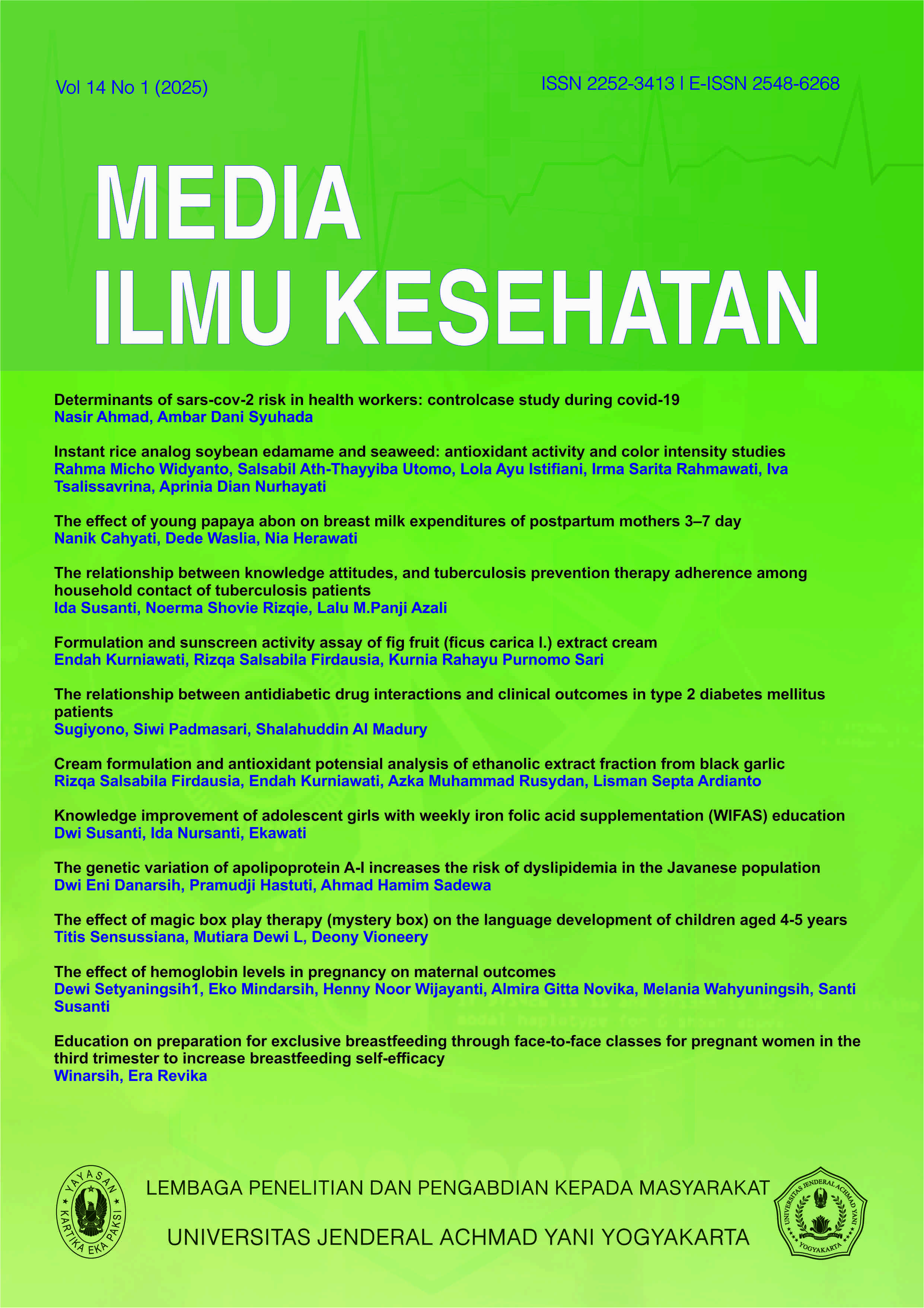The effect of young papaya abon on breast milk expenditures of postpartum mothers 3–7 day
DOI:
https://doi.org/10.30989/mik.v14i1.1353Keywords:
breast milk, production, postpartum, young papaya abonAbstract
Background: The number of breastfeeding problems in early postpartum, one of which is not smooth breast milk, results in low exclusive breastfeeding coverage in West Bandung Regency in 2021 which is 72.76%, Rongga Health Center January - May 2023 only 29%. One of the efforts to increase breast milk production by consuming young papaya fruit, processed into abon because it is much favored by all circles of society.
Objective: The purpose of the study was to determine the effect of young papaya abon on breast milk production of postpartum women on days 3-7, in the working area of the Rongga Health Center, West Bandung Regency.
Methods: Quantitative method and quasi experiment design of one group pre and posttest, population of 90 postpartum women, 20 samples of postpartum women on days 3-7 with quota sampling technique. Data collection with observation sheet instruments, SOP and Wilcoxon test.
Results: Statistical test results mean before intervention 2.20, mean after intervention 7.50 with p-value=0.0001 (α<0.05).
Conclusion: It is concluded that there is an effect of giving shredded young papaya on breast milk production of postpartum women on days 3–7. It is recommended that midwives provide care during the lactogenesis period in order to achieve successful breastfeeding and make innovations that can increase exclusive breastfeeding coverage.
References
1. Putri, Andini O., dkk. Air Susu Ibu (ASI) dan Upaya Keberhasilan Menyusui. e Mine. Banjar Baru; 2020.
2. Pattypeilohy, Aning., Henukh, Dina Melanieka S. Pengaruh Pemberian Air Rebusan Buah Pepaya Dalam Meningkatkan Produksi ASI Ibu Nifas Di Puskesmas Manutapen. CHMK Midwifery Scientific Journal Volume 2. Nomor 2 April 201; 2019.
3. Riyanto, Agus. Pengolahan dan Analisis Data Kesehatan. Nuha Medika. Yogyakarta; 2022.
4. Carolin, Bunga Tiara., Siauta, Jenny Anna., Damayanti, Irma. Pengaruh Buah Pepaya Muda (Carica Papaya Linnaeus) Terhadap Kecukupan ASI Pada Ibu Post Partum. Jurnal SMART Kebidanan. http://stikesyahoedsmg.ac.id/ojs/index.ph p/sjkb; 2021.
5. Siagian, Dewi Sartika., Herlina, Sara. Konsumsi Pepaya Hijau terhadap Peningkatan Produksi ASI. Jurnal Endurance: Kajian Ilmiah Program Kesehatan; 2019.
6. Istiqomah, dkk. Pengaruh Buah Pepaya Terhadap Kelancaran Produksi Asi Pada Ibu Menyusui Di Desa Wonokerto Wilayah Puskesmas Peterongan Jombang Tahun 2019‟, Buletin Penelitian Sistem Kesehatan; 2019.
7. Kementerian Kesehatan Republik Indonesia. Profil Kesehatan Indonesia 2020. Vol. 48, IT -Information Technology.
Jakarta; 2021. 1–480 p.
8. Rai, Ni Made Rai Widiastuti., Ni Ketut Ayu Sugiartini, Ni Wayan Sukma Adnyani. Praktik Menyusui Pada Ibu Nifas Di Wilayah Kerja Puskesmas I Denpasar Timur. Jurnal.Institutgrahaananda,ac.id; 2023.
9. Agustina, Novita., ASI dan Manfaatnya. Kemenkes; (2022). Available from https://yankes.kemkes.go.id/view_artikel/ 1460/asi-dan-manfaatnya
10. Astiti, Ni Luh Mira. Pembuatan “BONYA” Abon Berbahan Dasar Pepaya. Jurnal Mahasiswa Pariwisata Dan Bisnis; 2022: 1(4).988–1007.
https://dx.doi.org//10.22334/paris.v1i4
11. Notoatmodjo, S. Pendidikan dan Perilaku Kesehatan. Jakarta : Rineka Cipta; 2017.
12. Rohmat Kurnia. Fakta Seputar Pepaya. Buana Ilmu Populer, 2018.
13. Sastroasmoro Sudigdo. (2014). Dasar– Dasar Metodologi Penelitian Klinis.Jakarta: Sagung Seto. Edisi 5; 2014.
14. Sugiyono. Metode Penelitian Kuantitatif, Kualtatif dan R&D. Bandung. AlFABETA; 2017.
15. Wilda, I., & Sarlis, N. Efektivitas Pepaya (Carica Papaya L) Terhadap Kelancaran Produksi ASI Pada Ibu Menyusui. JOMIS (Journal of Midwifery Science); 2021 5(2), 158–166. https://doi.org/10.36341/jomis.v5i2.1692
16. Yenni, Angka At. Pengaruh Abon Pepaya Muda Terhadap Pengeluaran Asi Ibu Nifas Hari Ke 3 – 7 Di Wilayah Kerja Puskesmas Rongga Kabupaten Bandung Barat. Jurnal Jrik [Internet]. 2022; Available From: Https://Ejurnal.Politeknikpratama.Ac.Id/Index.Php/Jrikhalamanutama:Https://Ejurnal.Politeknikpratama.Ac.Id/Index.Php
17. Sebayang, Wellina BR. Pengaruh Konsumsi Buah Pepaya (Carica Papaya L.) Terhadap Peningkatan Produksi ASI. Jurnal Ilmiah Kebidanan Imelda; 2020.
18. Indah, Yuni Anugrah. Penatalaksanaan Pemberian Buah Pepaya Muda Untuk Memperlancar Produksi ASI. LTA. Universitas Muhamadiyah Tasik Malaya; 2019
19. Indrayani S. The Effect Of Papaya Toward Breast Milk Production In Postpartum Mother In The Working Areas Of Siak And Mempura Health Center. 2021;
20. Sari, Jumita,, Umami Da, Marzalena R. The Effect Of Papaya Feeding On Adequate Breast Milk In Postpartum Mothers In Lubuk Durian Community Health Center, North Bengkulu. 2022;10(2).
Downloads
Published
How to Cite
Issue
Section
License
Copyright (c) 2025 MEDIA ILMU KESEHATAN

This work is licensed under a Creative Commons Attribution-ShareAlike 4.0 International License.
Articles received and published by the Media Ilmu Kesehatan are by the publication, the copyright of the article is fully transferred to the Media Ilmu Kesehatan. All operational forms such as printing, publication, and distribution of hard file journals are carried out by the Media Ilmu Kesehatan. Articles that have finished the review process and have been declared accepted by the journal manager or editor will be asked to fill out a statement of submission of copyright by the journal secretary to the main author or correspondent author. The statement of transfer of copyright is signed with a seal and sent via email to journalmik2018@gmail.com and contacted the admin of the journal to be followed up on archiving. Journal managers and editors have the right to edit the manuscript according to the provisions of the writing rules in the Media Ilmu Kesehatan.
Articles that have been declared accepted either online through the author's account on the OJS website https://ejournal.unjaya.ac.id/index.php/mik or a letter of receipt of the article (LOA), as well as those that have been published on OJS are not allowed to be published in other journals, or proceedings. The number of authors with more than one and as the main author or designated as the correspondent writer must have coordinated with members of the research team. The order of the authors submitted in the article as the author of one, two, three and so on cannot be changed when the article is published unless an error occurs in the technical operation of the journal.












